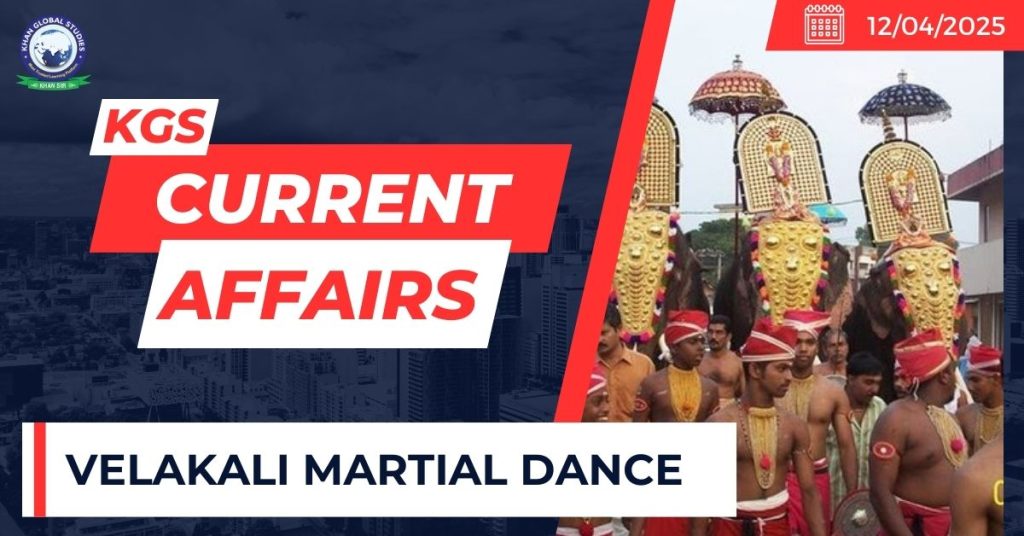Context:
Recently, the Velakali martial dance was performed at the Sree Padmanabha Swamy Temple in Thiruvananthapuram as part of the Painkuni festival in Kerala.
About the Velakali martial Dance
Velakali is a traditional martial dance from Kerala, with royal patronage, and is deeply rooted in Kerala’s cultural and spiritual traditions.
The dance has its origins in the Chempakasseri kingdom in Ambalappuzha and the hereditary commanders, Mathoor Panickers and Velloor Kurups, whose kalaris trained soldiers.
- The Chembakassery Kingdom, also known as the Kingdom of Purakkad, existed in central Kerala from the 12th to the 18th century.
Historical beliefs: The legends of Velakali say that once Sage Narada witnessed young Krishna engaging in mock combat with friends, inspiring the conversion of play into an art form by Sage Villvamangalam. This vision was passed on to the Chempakasseri Raja, who promoted it through the Mathoor Kalari as a sacred offering to Lord Krishna.
The concluding segment, called “Vela Ottam”, represents the Kauravas fleeing the battlefield in their defeat by the Pandavas, symbolizing the victory of good over evil.
Later, the dance migrated to other parts of South India, with some local flavour added to it.
Velakali is performed by men in typical traditional attire, which includes:
- The typical red head gear with the konda, shara mundu tied at the waist, golden, beaded neck piece, the mock churika and paricha (dagger and shield) held in the right hand and left hand respectively, mark the typical attire of performers of Velakali.
The performance begins with a ceremonial procession, where the deity is paraded on an elephant—a segment known as Thirumumbil Vela (“in front of the deity”).
When staged near the temple pond, it’s called Kulathilvela (“play at the pond”).
- Younger performers are positioned in the front, just behind senior leads.
- Older participants form the middle ranks.
- Flag bearers take the rearmost position, chanting vocally in sync with the performance.
The performance is accompanied by traditional instruments, such as the vela thakil (a smaller version of the perumbara),maddalam, elathaalam, kombu, and kurumkuzhal.
Modern Revitalisation of the Dance
Aswathi Thirunal Gouri Lakshmi Bayi’s authoritative book on Sree Padmanabha Swamy Temple mentions Velakali as one of the 99 arangams (art forms) that used to be patronised by the temple.
- Bayi is an Indian writer from Kerala and a member of the Travancore Royal Family.
Mohanankunju Panicker, encouraged boys from all communities to enroll in learning Velakali.
Today, Mathoor Kalari ((the traditional school for learning martial arts, set up by Mathoor Panicker) receives invitations from across India, especially where the Malayali community thrives, reflecting growing recognition of this martial dance’s dignity and cultural value
Painkuni festival
It is a prominent annual festival held in March and April celebrated at the historic Sree Padmanabha Swamy Temple, closely associated with the Royal Family of Travancore.
- Sree Padmanabha Swamy Temple is dedicated to Vishnu in Thiruvananthapuram, Kerala.
The festival commences with the kodiyettu, the hoisting of the ceremonial flag, signaling the start of ten days of elaborate celebrations and rituals.
The festival is marked by the installation of massive fiberglass figures of the Pandavas & mdash, the five sons of Pandu from the Indian epic Mahabharata & mdash, at the temple’s eastern entrance.
A highlight of the festival is the palli vetta (royal hunt) ritual, performed on the ninth day by the head of the Travancore Royal Family near the Vettakorumakan Temple in the Fort area. This ritual is a symbolic hunt, reflecting the royal traditions and customs that have been maintained through the ages.

